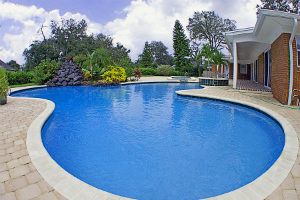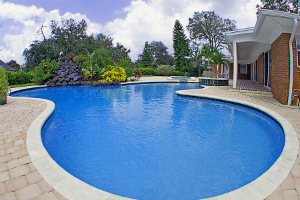A handy checklist for easy but effective pool maintenance.

By Karen Booth
Fail to take proper care of your pool and you could lose as much as 25,000 litres of water a year. When you consider the average home pool holds anywhere between 22,000 and 60,000 litres of water, that’s a major loss. By limiting the frequency and water quantity used in topping up, you can make massive water savings. It takes vigilance and a bit of effort, but it is achievable. Here’s a checklist for easy but effective pool maintenance:
1. Check for leaks
A pool that’s 20-plus years old may be prone to leaking and if your pool is letting a steady trickle of water escape, it could waste thousands of litres a year. Thoroughly check around the pool for damp spots and inspect the interior for cracks. And don’t forget to make sure there are no leaks from the plumbing, valves and pipe joiners.
2. Cover up
Reduce water evaporation and the need for frequent topping up by investing in a pool cover. Covers not only save water but help keep the pool clean and cut energy costs by reducing heat loss. The availability of rollers for covers makes it a quick and easy way of lowering costs and saving water.
3. Correct levels
If you overfill your pool it will reduce the effectiveness of the skimmer and waste water. To ensure the correct skimming action, saving water in the process, make sure the water level is only halfway up the skimmer opening.
4. Chemical balance
By maintaining correct water balance at all times you will reduce the need to empty your pool. Correctly balancing your pool involves adjusting the total alkalinity level, the pH levels and the sanitiser (whether added manually or via an automatic chlorinator).
5. Filtration
To remove the dust and debris collected by the filter, it must be “backwashed”. This procedure reverses the water flow through the filter and flushes the dirt down the drain. Only backwash the filter until the drain or sight glass is clear, which should just take a minute or two. Excessive backwashing can waste up to 2000 litres of water a year. If you have a cartridge filter, clean it with a chemical cartridge cleaner instead of the hose.
6. Rainwater
Outdoor pools and spas collect rainwater. This can overfill a pool, so bucket or siphon the excess to parts of the garden where rain doesn’t fall, such as on plants under eaves or larger trees. Just check first to make sure the plants won’t be affected by pool water.
7. Change behaviour
By doing things a little differently you can help to minimise water loss from your pool. For example, use a tap timer when topping up your pool so you can’t lose track of time and cause an overflow. Restricting boisterous behaviour, especially excessive splashing, can also help.
8. Water restrictions
If you’re a new or existing pool owner living in an area currently under mandatory water restrictions, call your local water business to find out what you can and can’t do. You may, for example, be required have to save water in other areas of the home if you want to fill or top up from the town water supply. And topping up may be restricted to certain days and times.





